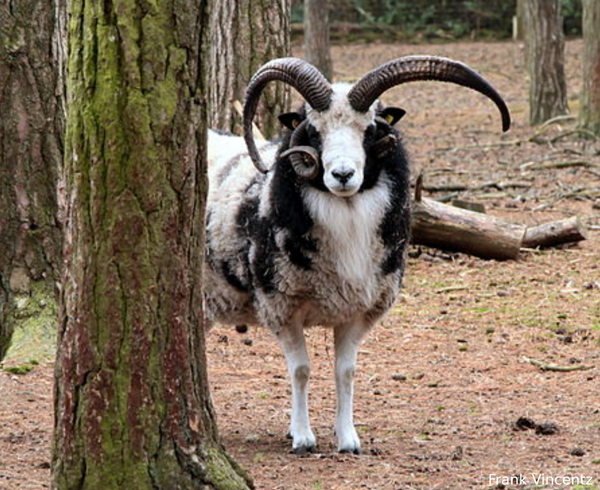Know Your Fiber: Jacob Wool
Posted on November 01 2018

Two horns, four horns, six horns! Jacob sheep, an adorable, multi-horned spotted sheep (most commonly they have four horns, but can have up to six) from the U.K., has seen a resurgence in popularity over the last several decades. The wool from these heirloom white and black spotted sheep with a goat-like build are especially popular with spinners and felters, who can get a range of naturally colored wool from a single sheep by either separating out the black and white wool, or by blending the two colors together.
Jacob sheep have pedigreed mythology. For centuries, many people have believed that Jacob sheep were descended from the same breed of sheep kept by Jacob as wages for working for his uncle, Laban, as described in Genesis. This story has persisted all the way up until present day, and still has its true believers. In 2017, Jenna and Gil Lewinsky of Canada made news for their project to bring Jacob sheep to Israel. Said Gil Lewinsky, “You know that Israel is built on Jewish people returning. Now you have a case of an animal from the Old Testament also returning.” In fact, it is difficult to say that Jacob sheep are the exact same sheep described in the Old Testament. In response to the Lewinskys’ project, sheep expert Elisha Gootwine of the Israeli Agriculture Ministry stated that Jacob Sheep do not have their origin in ancient Israel and that, “Jacob Sheep are related to Jacob the same as the American Indians are related to India.”
In the 13,000 years or so that sheep have been domesticated from the wild sheep of the Middle East, they have undergone many, many changes as separate breeds were developed throughout the world. A 2009 study used endogenous retrovirus genetic markers to determine that Jacob sheep appear to be related to sheep from Africa. If this is the case, it may lend some credence to another Jacob sheep origin story that has the first spotted sheep in England being seen after the destruction of the Spanish Armada in 1588; legend has it that these first Jacobs made it ashore from the wreckage of the Armada. Quite a few breeds of sheep arrived in the northern parts of Europe from Africa by way of Spain and Italy, who had strong sheep trading ties with various North African countries. So it is entirely possible, and even probable given the available current studies, that the legend of Jacob sheep arriving with the Spanish Armada might have some truth to it.
Regardless of how Jacob sheep first arrived in England, they became quite popular by the mid-1700s. During this period, there was a trend among English estate owners and park designers for carefully managed “natural” landscaping. A particularly popular landscape designer by the name of Lancelot “Capability” Brown loved the unique look of Jacob sheep. With their spotted coats and frequently multiple horns (both male and female Jacob sheep can have either 2, 4 or 6 horns), they were an attractive sheep that Capability Brown enjoyed adding as elements to his parks and landscapes. Capability Brown likely saw another benefit to using Jacob sheep aside from their attractiveness. Being a primitive sheep that were largely left to their own devices, Jacob sheep retained the survival traits associated with many primitive breeds including being relatively disease resistant, giving birth on their own easily, and efficiently adapting to a variety of weather and grazing condition. In short, Jacobs were the ideal sheep to let wander around estates and parks without needing too much attention. Where Capability Brown went, other landscape designers followed, and soon the Jacob become the most popular park sheep in England.
It is thought that the first Jacob sheep in North America were imported during the mid-1900s as an exotic addition to zoos. With their frequently multiple horns, Jacob sheep were likely a popular and odd-looking exhibit. It’s not known exactly when the first Jacob sheep in North America made their way to farms, but we know that additional imports of Jacob sheep also occurred during the 1970s and the 1980s, and their popularity has only increased since then. In 1989 the American Minor Breeds Conservancy helped the Jacob Sheep Breeders Association (JSBA) create the first North American Jacob sheep registry, with 400 sheep making up the first registered Jacob sheep in North America. Most Jacobs in North America today are descended from these sheep.
Being a primitive sheep, Jacob sheep wool can have a range of fineness and staple lengths. Jacob wool ranges from 26-37 microns and the staple length can be medium to long at a length of 3-7 inches. This makes Jacob wool a sought after fiber for spinners and other fiber artists seeking a durable but soft wool with a good staple length. Even though the diameter of Jacob wool is wider than that of some of the finer wool breeds like Merino, it is very pleasant to work with. It has a fair amount of loft and spring to it, and has just enough luster to give the finished yarn a beautifully subtle sheen. Jacob sheep are white with large black spots, and the black spots have very well defined edges. This allows the white and black wool from the sheep to be easily separated, creating two colors from the same sheep that can then be spun into natural white or black yarn, or blended to create a variety of shades of gray.
We carry Jacob top at Northwest Yarns for spinners, felters, and other fiber artists. Check out our stock of Jacob wool online or in our shop, as well as our other breed specific fibers, and start exploring the vast world of single-breed wool!

Follow US